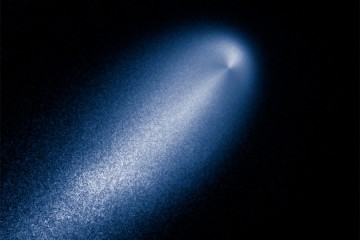NASA's Mercury-orbiting spacecraft Messenger spacecraft has captured images of two comets, ISON and Encke, setting the stage for observations later this month when both comets will be substantially brighter and much closer to Mercury and the sun.
ISON was discovered in September 2012 by amateur Russian astronomers, who observed it with a 16-inch telescope that is part of the International Scientific Optical Network (ISON) after which the comet was named. On Nov. 28, ISON will fly within 700,000 miles of the sun's photosphere, at which time it is expected either to flare brilliantly or disintegrate.
As part of an ISON observation campaign involving ground- and space-based NASA observatories, as well as many other observatories around the world, Messenger has been poised for several weeks to collect observations of ISON. From Nov. 9 through Nov. 11, the probe's Mercury Dual Instrument System (MDIS) captured its first images of the comet.
"We are thrilled to see that we've detected ISON," said Ron Vervack of the Johns Hopkins University Applied Physics Laboratory, who is leading Messenger's role in the ISON observation campaign. "The comet hasn't brightened as quickly as originally predicted, so we wondered how well we would do. Seeing it this early bodes well for our later observations."
A few days earlier, from Nov. 6 through Nov. 8, Messenger's imagers picked up their first snapshots of Encke. Unlike ISON, Encke has been known for quite a while. It was discovered in 1786 and recognized as a periodic comet in 1819. Its orbital period is 3.3 years—the shortest period of any known comet—and Nov. 21 will mark its 62nd known pass by the sun.
"Encke has been on our radar for a long time because we've realized that it would be crossing Messenger's path in mid-November of this year," Vervack said. "And not only crossing it, but coming very close to Mercury."
The early images of both comets are little more than a few pixels across, Vervack said, but he expects improved images next week when the comets make their closest approaches to Messenger and Mercury.
"By next week, we expect Encke to brighten by approximately a factor of 200 as seen from Mercury, and ISON by a factor of 15 or more," Vervack said. "So we have high hopes for better images and data."
Messenger is a NASA-sponsored scientific investigation of the planet Mercury and the first space mission designed to orbit the planet closest to the sun. The Messenger spacecraft, built and operated by the Applied Physics Laboratory, launched on Aug. 3, 2004, and entered orbit about Mercury on March 18, 2011.
Posted in Science+Technology
Tagged applied physics laboratory, space









